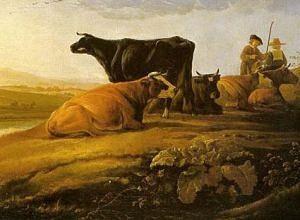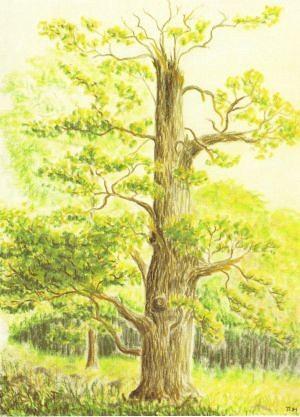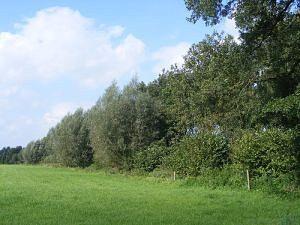
If you wish to understand yourself,
seek yourself in the wideness of the world;
if you wish to understand the world,
seek in the depths of your own mind.
Rudolf Steiner
Life ether: cohesion within an objectís course of life
Attitude
Life ether is characterised by integration and individuality, which means that the observation is focused on that which unifies (integrates) everything while at the same time creating a unique individual. What you're looking for is that which always allows you to recognise an object (a plant, a tree, an animal, a human being, a place, a landscape, a farm, etc.), and you also look for decisive events in the object's course of life. This transcends the previous mode of observation, in that you're now trying to identify the unique aspects of the course of the object's life. Any organism, landscape or farm, anything that is alive, has its own course of life, which results from the impulse such an organism etc. had when it came into existence, and is shaped by its interactions with the specific circumstances of space and time, important events and human intentions. This leads to different, unique outcomes in different places.
Bockemühl calls this mode of observation the context of life or meaning: it is that which links the events in a life; it represents the meaning of a life. If you have studied an object for a long time, you have gradually become familiar with its life story and you can see this reflected in its current appearance. This shows you that you have transcended the 'context of transformation'. You have come to know the object as an individual, though the changes.
You get a feeling for the context of life by studying how the object's present appearance developed from the potential options that were present at the moment it arose. You do this by examining the circumstances of space and time, the important events and human actions. You start to recognise individual lines and patterns. You can translate all of this into an image in your mind, but your will is also intuitively affected, as it becomes clear to you in what direction the development could proceed. You can see the preferred development and you can imagine various scenarios and compare the effects they would have.
Results and examples
The result of this mode of observation is that it tells you how the object came to be what it is now, what its 'biography' looks like. It is not easy to put this into words; you're able to see lines and patterns and to develop an image. You also see lines from the past that indicate what its future development might look like, or you can intuitively indicate how the development could go from here.
If the question that prompted your observations had to do with solving a problem, you can now provide an answer. You know what possible actions you can take and have a realistic idea of their consequences. You can assess whether these would fit into the object's 'biography'.
If you lose sight of a man you used to know well, and you meet him again after 25 years, you may not recognise him at first. You can still imagine his face as it used to be, but it's hard to predict the changes since then. But as soon as you look into his eyes, or when he starts to talk or laugh, or makes a particular gesture, you suddenly recognise him. This means that there are certain aspects that change and others that don't change. If you then get to talk to him, you can understand the changes; they become clear from the circumstances and events in that person's life.
One of the ashes in a windbreak looks poorly developed and has an unusual shape. It is flattened on two sides and its branches are somewhat bent to the east. The tree currently stands in the middle of the windbreak, one half of which is younger than the other. There's another windbreak, at a right angle to this one, at a distance of about 20 m. The unusual tree looks as if it has been pounded by the winds for many years. An inquiry shows that the windbreak in which the ash stands has been planted in two stages; the younger part was planted only seven years ago. In addition, the two separate windbreaks used to be connected up to that time. The unusually shaped tree used to stand on the corner linking the two. When the new part was planted, the two parts of the old windbreak became separated by a gap.
An extensively managed, biodynamic mixed farm, which has developed gradually and has maintained many relations with its neighbours, shows various tendencies indicating a lack of equilibrium: an acidified, heavy clay soil, deteriorating soil structure, sheep suffering from liver fluke, flooded grasslands, a failed attempt at beekeeping. All of these problems indicate an excessive influence of the cold, wet earth pole. It seems a good idea for the further development of the farm to stimulate the warmth and air poles. It is decided to construct paths made of shell clay, dig a pond for the water, create some elevated, dry patches among the grassland and to plant flowering shrubs for the bees (Vereijken, van Gelder & Baars, 1995).

Life ether integrates and gives the context a meaning

This oak had an eventful life

A flowering hedge
Exercises
Biography
- After having described the contexts of phenomena and transformation for an object, you can decide what major events or human intentions have had a decisive influence on the object's current appearance.
- Indicate how these are reflected in the object, that is, how the object and its environment relate to each other.
- Summarise this in a biographical outline, or in a few key words.
- Indicate what its future development might look like.
- What types of solutions can you come up with for any problems?
Further developments
- Compare what the object looks like now and what it might ideally look like.
- Describe the biographical lines.
- How could its development go from here; what solutions do you envisage and what effects would each of them have?
The contexts
Try to describe the difference in attitude between the 'context of phenomena', the 'context of transformation' and the 'context of life'. Can you relate these to the concepts of imagination, inspiration and intuition?
